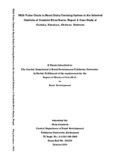Please use this identifier to cite or link to this item:
https://elibrary.tucl.edu.np/handle/123456789/2261| Title: | Milk Value Chain in Rural Dairy Farming System in The Selected Districts of Gandaki River Basin, Nepal: A Case Study of Gorkha, Tanahun, Chitwan Districts |
| Authors: | Banskota, Niraj |
| Keywords: | dairy production;Dairy Farming;Milk Value |
| Issue Date: | 2015 |
| Publisher: | Department of Rural Development |
| Abstract: | The Research entitled Milk Value Chain in Rural Dairy Farming System in the Selected Districts of Gandaki River Basin, Nepal is an academic research work for MA, Rural Development. The General Objective of this study is to analyze the existing status of milk production and milk products value chain in Chanuli, Dumre and Palungtar. It studies the in-depth assessment of the milk and milk products marketing through identifying actors’ factors and relationships. The study follows descriptive and exploratory research design where both qualitative and quantitative information have been included. The universe of the study was 500 samples. The farmers providing at least 10 liters of milk production in the cooperatives were selected. Simple random sampling was used as respondents .The sample size was 18 % of the total universe balancing the same percentage from the existed milk cooperatives. Both secondary and primary data from the five major milk producing was collected covering the whole milk value chain from production to the market as well as the policy, regulatory and institutional framework under which the sub-sector is operating. Actively working intermediates (key informants) were also used. Household survey, interview, observation, focused group discussion and interview with the key informants were adopted to collect data. For this, structured questionnaire and guidelines were developed. The GRB region is rich in animal resources as it owns ~20% of cattle population and ~30% of buffalo population of the country (MoAD, 2012). Cattle in Gandaki River Basin are almost entirely of the zebu type and are sources of milk. Buffaloes alone contribute about 84% of the milk production in the GRBs. There are approximately 1.5 million cattle, 1.5 million buffaloes, 0.1 million sheep, 2 million goats. Livestock production in pastoral areas system that supports an estimated 10% of population covers 50-60% of the total area. The key actors in the formal dairy value system include milk producer farmers, MPCSs, MCCs, and milk processing plants/cheese factories. Firstly, there are rural farmers and their function is to be engaged in milk production. The next are MPCSs established in the rural areas, Milk and milk products were channeled to consumers v through both formal and informal marketing systems through private and DDC businesses. The strength of dairy sector to develop the rural area is; strong dairy cooperatives with their presence from the grass root level i.e. rural area to the source of income. The pragmatic weakness of the dairy sector were hygienic milk production/ lack of stringent measure on quality control / lack of awareness, scattered production and difficult geography- increased cost in collection and transportation, poor infrastructure for milk collection, chilling and transport etc. The opportunities are wide as livestock are widely distributed with even distribution of cattle and buffaloes throughout, consumption of milk and dairy products is traditional but there is increasing gap between demand for and supply of milk and milk products, market opportunities of milk and milk products have increased particularly in the densely populated urban areas. Compulsion for coexistence of productive and unproductive (old, male, diseased) cattle further depleting scarce feeding resources, poor competitiveness- upsurge in import of milk and milk products, , increasing cost of inputs including labor, shortage of labor- young generation seeking jobs overseas, reluctance of financial institutions on lending for agriculture, high opportunity costs of land and labour particularly around the main highways and townships where the dairy farming activities pragmatic threats of the milk producing areas in the Gandaki river basins. There are opportunities which the competitiveness of milk subsector that can be built up on untapped high milk production potential. Since, small portion of the total marketable milk reaches the terminal market due to different needs to be addressed for overcoming value chain approach. These supports for the organizational and business management and development gaps among the small- scale milk processing units. The main theme of the recommendation is that; any interventions in the milk and milk value chain should address the poor and women pastoralists/ producers for livelihood enhancement of these poor. vi |
| URI: | http://elibrary.tucl.edu.np/handle/123456789/2261 |
| Appears in Collections: | Rural Development |
Files in This Item:
| File | Description | Size | Format | |
|---|---|---|---|---|
| cover.pdf | 334.48 kB | Adobe PDF |  View/Open | |
| chapter.pdf | 1.02 MB | Adobe PDF |  View/Open |
Items in DSpace are protected by copyright, with all rights reserved, unless otherwise indicated.
